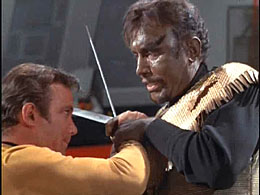





There are some episodes of Star Trek that transcend TV and become small masterpieces of literature. City on the Edge of Forever deals with themes of fate, Amok Time with identity, A Taste of Armageddon with social conditioning. “Day of the Dove” is a parable, an examination, a rumination on the sources of war and violence. It treats its premise — an alien life force that feeds off of the human emotion of anger — with surprisingly little depth. Clearly the intention is to allow the viewer to make current paralles (as easy to do in 1969 as today) and try and fill the real-world gaps. If world bodies are instigated to fight, who gains? Where does human nature end and manipulation begin? When is it noble to be strong and when are we just caving to our baser instincts? What does one do when a foe refuses to accept reason? What if a foe would prefer mutually assured destruction to peace? These are very deep, fundamental questions — certainly nothing that can be answered in fifty minutes of television. And perhaps “Day of the Dove’s” dovetail into peace is far-fetched. It is still welcomed to see these themes played out — and played out in a cogent, strategic, well-structured manner. . .a manner that is also thrilling what with the fighting Klingons with swords and self-incinerating dilithium crystals!








Well now, you have taught me something with this review. Well done!
“Where does human nature end and manipulation begin? When is it noble to be strong and when are we just caving to our baser instincts? What does one do when a foe refuses to accept reason?”
I never thought of those things before now. Perhaps because I never gave this one a real chance. I always thought this one was silly.